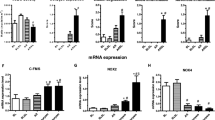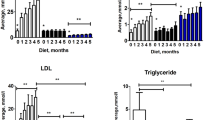Summary
In spontaneously atherosclerosis-susceptible White Carneau pigeons, intimai cushions that appear at birth near the coeliac branch of aorta do not progress into atherosclerotic lesions. However, the area across from the intimai cushion (so called ‘lesion area’) a) accumulates cholesteryl esters b) synthesizes more PGE2 and c) eventually develops into complicated atherosclerotic plaques. When DOCA-salt hypertension is induced in the pigeons, the ‘intimai cushion’ area displays a) accumulation of increasing amounts of cholesteryl esters and b) increase in the synthesis of all prostaglandins (particularly PGE2) from C14-arachidonic acid and c) approaches similarity to the ‘lesion area’ in the magnitude of these changes. These results suggest that under the influence of a risk factor, the ‘intimai cushion’ can acquire biochemical properties of the atherogenic areas of the aorta.
Similar content being viewed by others
References
Clarkson TB, Pritchard RW, Metsky MG, Lofland HB (1959) Atherosclerosis in pigeons: Its spontaneous occurence and resemblance to human atherosclerosis. Arch Pathol 68: 143–147
Deming QB (1968) Blood pressure: Its relation to atherosclerotic disease of the coronaries. Bull NY Acad Med 44: 968–980
Folch J, Lees M, Sloane-Stanley GH (1957) A simple method for the isolation and justification of total lipids from animal tissues. J Biol Chem 226: 497–509
Koletsky S, Roland C, Rivera-Valez KM (1968) Rapid acceleration of atherosclerosis in hypertensive rats given a high fat diet. Exp Mol Pathol 9: 322–338
Kuksis A (1966) Quantitative lipid analysis by combined thin-layer and gas-chromatography systems. Chromat Rev 8: 172–197
Lauper NT, Unni KK, Kottke BA, Titus JL (1975) Anatomy and histology of aorta of White Carneau pigeon. Lab Invest 32: 536–551
Lowry OH, Rosebrough NJ, Farr AL, Randall RJ (1957) Protein measurement with Folin-Phenol reagent. J Biol Chem 193: 265–270
McGill HC Jr (1980) In: Lauer RM, Skekelle RB (eds) Childhood prevention of atherosclerosis and hypertension, Raven Press, New York, pp 41–60
Moncada S, Gryglewski RJ, Bunting S, Vane JR (1976) An enzyme from arteries transforms prostaglandin endoperoxides to an unstable substance that inhibits platelet aggregation. Nature 263: 663–664
Rymazewski Z, Langelier M, Carlo IA, Subbiah MTR, Kottke BA (1976) Age related alteration in blood pressure and arterial sterol accumulation in spontaneously atherosclerosis susceptible and resistant pigeons. Atherosclerosis 23: 111–116
Santerre RF, Wight TN, Smith SC (1972) Spontaneous atherosclerosis in pigeons. A model system for studying metabolic parameters associated with atherogenesis. Am J Pathol 67: 1–21
Subbiah MTR (1976) White Carneau pigeon. An ideal model for the study of progression and regression of atherosclerosis. Biochem Exp Biol 12: 229–246
Subbiah MTR, Unni KK, Kottke BA, Carlo IA, Dinh DM (1976) Arterial and metabolic changes during critical period of spontaneous sterol accumulation in pigeon aorta. Exp Mol Pathol 24: 287–301
Subbiah MTR (1978) Prostaglandins and the arterial wall: A potential avenue for investigation in the pathogenesis of atherosclerosis. Mayo Clin Proc 53: 60–62
Subbiah MTR (1978a) PGE2 biosynthesis and effect in pigeon aorta. Possible role in atherogenesis. Atherosclerosis 29: 487–495
Subbiah MTR (1979) On the characterization of PGE2-9-keto reductase from aorta. Proc Soc Exp Biol Med 161: 158–161
Subbiah MTR, Gallon L, Yunker R (1980) Studies of aggregation and thromboxane B2 synthesis in avian thrombocytes: Comparison between atherosclerosis-susceptible and resistant breeds. Thromb Haemost 43: 189–191
Subbiah MTR, Deitemeyer D, Yunker RL (1981) Regional differences in atherosclerosis-susceptibility: Relationship to lipid accumulation and prostaglandin biosynthesis. Virchows Arch [Cell Pathol] 36: 41–46
Tesar GE, Kottke BA (1978) Location and sequence of atherosclerotic plaque formation in White Carneau and Show Racer pigeons. Arch Pathol Lab Med 102: 581–586
Author information
Authors and Affiliations
Rights and permissions
About this article
Cite this article
Subbiah, M.T.R., Bale, L.K., Dinh, D.M. et al. Regional aortic differences in atherosclerosis-susceptibility: Changes in prostaglandin biosynthesis and cholesterol accumulation in response to desoxycorticosterone (DOCA)-salt induced hypertension. Virchows Archiv B Cell Pathol 37, 309–315 (1981). https://doi.org/10.1007/BF02892579
Received:
Accepted:
Issue Date:
DOI: https://doi.org/10.1007/BF02892579




